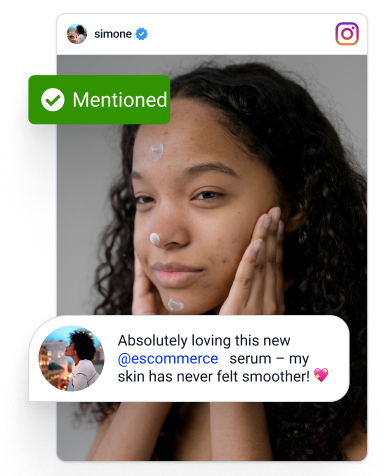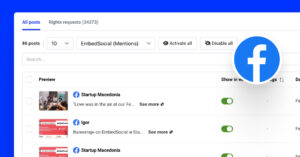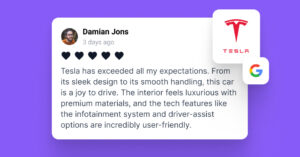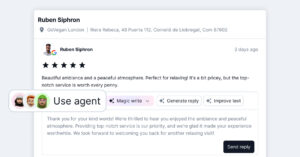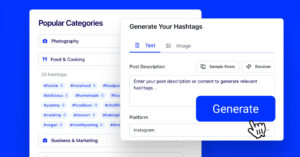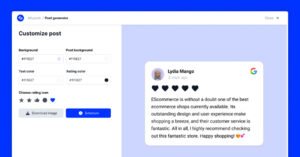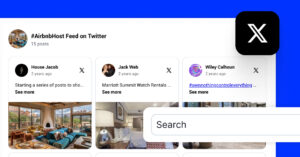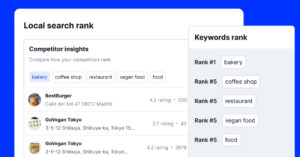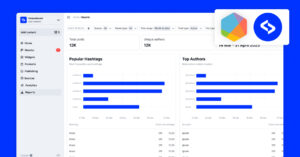Marketers are crazy for data! After all, the best decisions you can make are based on relevant data about your target consumer and your competitors!
This is where social listening comes in—monitoring relevant conversations about your brand, industry, or competitors to gain insights and improve strategies.
You must start looking into the user-generated content created both by other brands and your target audience, as they offer endless opportunities to learn.
Want to know what you’re doing right, where can you improve, how consumers feel about your products and services, and what resonates with them?
Then, keep on reading, as I tell you all there is to know about social listening!
What is social listening?
Social listening is like eavesdropping on conversations about your brand—but in a totally ethical and smart way. It’s all about tracking what people are saying about your business, your competitors, and your industry across social media channels and other platforms.
‘Social listening’ meaning
But it’s more than that since social listening goes deeper—it helps you understand why people are saying what they do about your products and competitors.
Think of it as a way to tune into the pulse of your audience and use that knowledge to make better decisions, build stronger connections, and even get social proof.
When done right, social media listening helps you:
- Discover marketing messages that strike a chord with your audience;
- Uncover new challenges and pain points your customers are experiencing;
- Explore trending topics and interests that captivate your customer base;
- Identify strategies to give your business an edge over competitors;
- Spot opportunities to engage in conversations with your audience.
You need social listening if you want to know who your target audience is, what they want, how they engage with you, and why they like or dislike your products.
Social listening vs social monitoring
While used interchangeably, social listening and social monitoring are different!
Social monitoring relies on data like brand mentions and unique brand hashtags to show you what exactly people are saying on social media. On the other hand, social listening goes beyond the numbers to describe the general sentiment about your brand and competitors.
So while social monitoring means gathering information in the short term, social listening is a long-term strategy for analyzing data and extracting insights.
Here’s a brief overview of both concepts and how they differ:

Example: Imagine Coca-Cola launches a new flavor and tracks the hashtag #NewCokeFlavor. Social monitoring would show how many people mentioned the hashtag and whether the reaction was positive or negative.
Social listening, on the other hand, would analyze the deeper sentiment behind these mentions—are customers excited about the flavor, suggesting tweaks, or comparing it to a competitor’s product like Pepsi?
This insight could help Coca-Cola adjust its marketing strategy or even tweak the product based on audience feedback.
Read more:
6 reasons why social listening is important for brands
So, why is social listening more than just a marketing buzzword? When done right, it’s a game-changer for any brand for several reasons:

- Understand your audience on a deeper level—social listening helps you go beyond surface-level demographics to uncover what your customers truly care about, their pain points, how they feel about your brand, and how they respond to your marketing campaigns;
- Stay ahead of competitors—by monitoring conversations about your competitors, you can identify their weaknesses, learn from their successes, and find ways to outshine them;
- Prevent potential PR crises—catching negative conversations early can help you address issues before they escalate, protecting your social media reputation;
- Shape your product or service offerings—listening to feedback, both good and bad, gives you insights into what customers want, helping you refine your offerings;
- Craft better marketing strategies—understand which messaging resonates most with your audience to create campaigns that hit the mark every time;
- Spot emerging trends and opportunities—keeping an ear to the ground helps you identify social media trends and seize opportunities to engage your audience.
By integrating social listening into your strategy, you’re not just monitoring social conversations—you’re building a brand that listens, evolves, and thrives.
How to create an effective social listening strategy?
So, how do you create an effective social listening strategy? Well, there are several steps involved to ensure you maximize your time and efforts:

1. Set clear objectives
Point: Anchor your strategy by defining a clear business goal behind your social listening efforts.
Evidence:
🍿 When McDonald’s noticed the viral Grimace Shake trend on TikTok, they were able to quickly engage with playful, on-brand content. That wasn’t by accident—it was the result of clear monitoring goals tied to real-time trend spotting.
Explain:
Start by identifying what you want to achieve through social listening. This will shape your entire approach.
Break down your objectives into categories like:
- Brand sentiment—Are customers happy, confused, frustrated, or loyal?
- Competitor tracking—What are people saying about rival brands or products?
- Trend spotting—What new conversations or cultural shifts are emerging?
Knowing your “why” helps you focus your tools, filter your keywords, and interpret the right data when it counts most.
✅ Write down your top 3 social listening goals—each one should be tied to a potential action or metric (e.g., improving sentiment, increasing Share of Voice, refining messaging).
2. Pick the right social listening tools for the job
Point: Choose a platform that matches your objectives, not just your budget.
Evidence:
🛠️ Poppi used EmbedSocial to track 500+ influencer-generated posts during its $800K campaign, analyzing sentiment and UGC to evaluate what resonated and what missed the mark.
Explain:
Good tools do more than track mentions—they interpret emotion, map engagement patterns, and surface trends. Consider tools like:
- EmbedSocial—for UGC tracking, multi-location brand mentions, and embeddable widgets;
- Sprout Social—for comprehensive social media management;
- Talkwalker—for global sentiment analysis and competitive benchmarking.
If your goal is to collect UGC from social media and display it across your website, you’ll want a platform that supports aggregation and reuse.
Make sure your tool offers filters by platform, audience segment, and geography for more targeted insights.
For more platform options, check out our roundup of the best social media monitoring tools to compare features.
✅ Test at least two tools and evaluate how well they align with your listening goals.
3. Focus on the platforms that matter
Point: Prioritize the platforms where your audience actually talks about you.
Evidence:
📸 During Paris Fashion Week, over 4,000 out of 6,500+ posts tracked were text-based and primarily on X (Twitter), showing that focusing on Instagram alone would have missed key insights.
Explain:
You don’t need to track every social platform. Focus on:
- Instagram & TikTok for B2C and UGC-heavy brands;
- LinkedIn for B2B and professional discussions;
- X (Twitter) & Reddit for trending commentary and real-time feedback.
Let your audience behavior—not assumptions—guide where you listen.
✅ Check your current engagement metrics to identify your top-performing platforms before you start listening.
4. Define your keywords and topics
Point: Use smart keyword targeting to avoid irrelevant noise and focus on insights that matter.
Evidence:
🔍 Nike uses social listening to monitor terms like “sustainable shoes” and “eco-friendly gear,” allowing them to spot trends and refine product messaging for green-conscious customers.
Explain:
List keywords in four buckets:
- Brand terms—“EmbedSocial”, “Embed Social”, “Embed widget”;
- Product names & features—“Instagram UGC”, “review widgets”;
- Competitor mentions—direct rivals or indirect alternatives;
- Industry terms & trends—like “social proof” or “cheap flights”.
Use variations, misspellings, and hashtag forms to broaden coverage—but filter aggressively to stay relevant.
✅ Build your keyword bank and review it monthly for relevance and performance.
5. Set up alerts and automate tracking
Point: Use automation to stay responsive without drowning in data.
Evidence:
🔔 Chipotle set up real-time alerts to respond to “free guac” mentions during campaigns, leading to rapid engagement and improved sentiment scores.
Explain:
Most tools let you configure:
- Real-time alerts—for key mentions or crisis keywords like “bad service”;
- Daily/weekly digests—for ongoing monitoring;
- Smart filters—to exclude spam or off-topic mentions.
Keep alerts focused and meaningful to avoid “alert fatigue.”
✅ Start with just 3–5 high-priority alert terms and expand as needed.
6. Analyze the data thoroughly
Point: Move beyond raw mentions to identify trends, patterns, and opportunities.
Evidence:
📊 After a product launch, Starbucks tracked spikes in negative sentiment tied to “wait time” and quickly added more staff during peak hours—reducing complaints by 40%.
Explain:
Look at:
- Sentiment—Are mentions leaning positive, negative, or neutral?
- Patterns—Do issues emerge after campaigns, launches, or updates?
- Themes—What topics dominate conversations (e.g., price, delivery, design)?
Context matters—volume alone doesn’t tell the full story.
✅ Create a weekly insights summary that includes top sentiments, themes, and possible actions. For instance, if you notice a recurring complaint about shipping times, this customer feedback can become a powerful input for improving operations.
7. Act on what you learn
Point: Social listening means nothing if it doesn’t drive decisions.
Evidence:
🌱 Ben & Jerry’s used social listening feedback to release new plant-based flavors, aligning product innovation with audience demand.
Explain:
Use the data to:
- Adjust messaging—If a tagline feels off, test new copy;
- Refine products—If users praise a specific feature, spotlight it;
- Engage directly—Thank advocates, respond to complaints, or ask for more info.
Treat social listening as your real-time user research lab.
✅ Create a “You said / We did” content series to show customers you’re listening.
8. Measure your success
Point: Track metrics that reflect actual progress, not just activity.
Evidence:
📈 After launching a sentiment-driven campaign, Spotify tracked a 15% increase in Share of Voice against Apple Music across X and Instagram.
Explain:
Use metrics like:
- Sentiment score—Is perception improving?
- Engagement volume—Are more people talking about you?
- Share of Voice—How do your mentions compare to competitors?
One of the best metrics to benchmark your brand presence is Share of Voice—how often you’re mentioned compared to your competitors.
Most tools also offer advanced stats like impressions, clicks, reach, or engagement rates.
✅ Establish a baseline before launching campaigns to measure true lift.
9. Refine and repeat
Point: Social listening is never “set it and forget it.”
Evidence:
♻️ Duolingo shifted more listening efforts to TikTok as Gen Z engagement soared, ensuring their strategy matched audience behavior.
Explain:
Revisit your strategy every quarter:
- Review your goals—Are they still aligned with business priorities?
- Update your keywords—What’s still relevant? What’s not?
- Explore new platforms—Don’t overlook Reddit, YouTube Shorts, or Threads.
Social listening is iterative. Your brand, audience, and platforms evolve—your strategy should, too.
If you’re ready to operationalize these steps, EmbedSocial’s social listening solution brings it all together with built-in UGC features.
✅ Schedule a quarterly listening audit to review performance and refresh your approach.
Pro tip: After collecting data, embed Instagram and Facebook mentions on your website to showcase UGC and drive conversions.
What social media listening tool should you choose?
An essential step in creating and implementing a social listening strategy is using the proper social listening tools, and EmbedSocial is among the best ones:

As the No. 1 UGC platform and social media aggregator, EmbedSocial collects, manages, and displays content from every social media platform.
However, in addition to embedding social media posts on your websites, it offers plenty of social listening features.
For starters, you can track hashtags and mentions across multiple business locations, languages, and regions and filter through all relevant social media posts.
But, that’s not all! These are all the social listening benefits you get:
- UGC aggregation—automatically collects and displays content from various social media platforms in embeddable website widgets to boost your credibility;
- Pro tip: You can complement your Instagram social listening and Facebook social listening strategies with bespoke website widgets.
- Real-time monitoring—track brand mentions, hashtags, and keywords across multiple channels instantly, enabling prompt responses to customer feedback and emerging trends;
- Sentiment analysis—assess the tone of online conversations to understand public perception and make informed decisions to improve customer satisfaction;
- Customizable reports—generate detailed analytics reports tailored to your specific needs, facilitating data-driven strategies and demonstrating ROI;
- Seamless integration—easily integrate with your existing marketing tools and workflows, ensuring a cohesive approach to social media management.
As you can see, in addition to being a powerful social media management tool, you can leverage EmbedSocial’s robust features to effectively monitor and engage with your audience, turning insights into impactful actions that drive brand growth.
You don’t have to commit to it since it has a free tier and a 7-day free trial of the $29 per month paid tier. That said, there are higher tiers with advanced features, such as the PRO Plus ($49/month), the Premium ($99/month), and a custom Enterprise plan.
Tips for optimizing your social listening strategy
Refining your social listening approach is essential as trends and tools evolve. Here are key tips to ensure your strategy stays effective in 2025:

- Leverage AI and automation tools—use AI-powered features like sentiment analysis and predictive insights for faster and more accurate data interpretation;
- Expand your listening to niche platforms—monitor emerging platforms like TikTok or Reddit to uncover trends competitors might miss;
- Track sentiment, not just mentions—focus on how people feel about your brand to spot areas for improvement or capitalize on positive buzz;
- Segment your audience for better insights—filter social listening data by demographics or regions to tailor your strategy to specific audience needs;
- Engage directly with your audience—respond to online reviews and mentions to build stronger connections and show your brand is listening;
- Regularly review your strategy—revisit your goals, keywords, and tools quarterly to adapt to changing trends.
Optimizing your social listening strategy will keep you ahead of the curve and ensure your efforts continue driving meaningful results.
How to do social listening with a tool: 3 real-world examples
To show you just what EmbedSocial’s AI-powered social media listening tool can do, I used it to analyze three viral social media events:
1. The Viral “Death of Duo” Campaign
When Duolingo launched its cryptic “Death of Duo” stunt, the internet exploded with theories, memes, and debates. To understand the full impact, we ran a sentiment and engagement analysis on 1,336 posts using EmbedSocial’s dashboard:
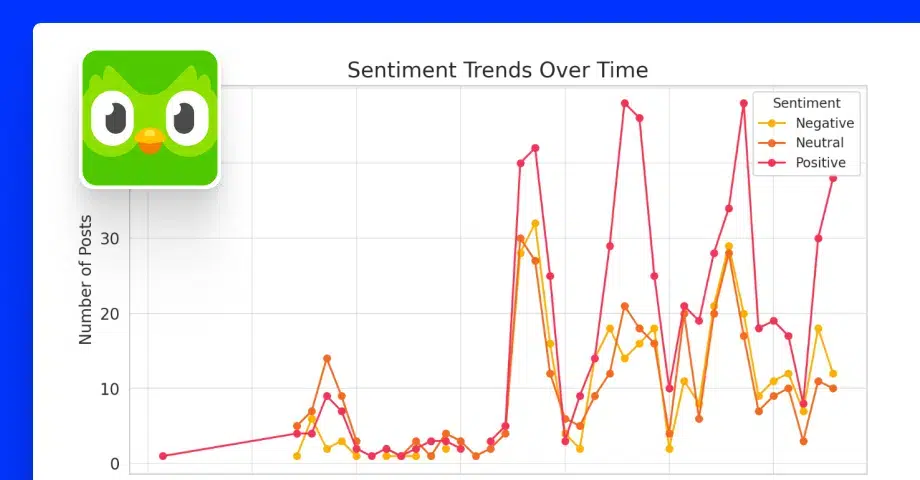
What the data revealed:
- Text ruled the day—More than 60% of posts were text-based, while memes and short-form videos amplified engagement.
- Top hashtags and contributors—Hashtags like #DeathOfDuo and #JusticeForDuo surged, but nearly half of the posts used none—highlighting missed reach potential.
- Sentiment breakdown—Humor dominated the positive reactions, while confusion and concern fueled the negative ones.
The takeaway:
Viral stunts come with risks. Social listening not only showed how Duolingo’s campaign earned attention but also highlighted the importance of clarifying brand messaging across platforms to avoid misunderstanding.
2. Poppi’s $800K Influencer Stunt
Poppi, the prebiotic soda brand, went bold with a high-budget influencer campaign—sending full vending machines to select creators. Using EmbedSocial, we monitored and analyzed over 500 posts to understand the campaign’s public reception and lessons for future marketers:
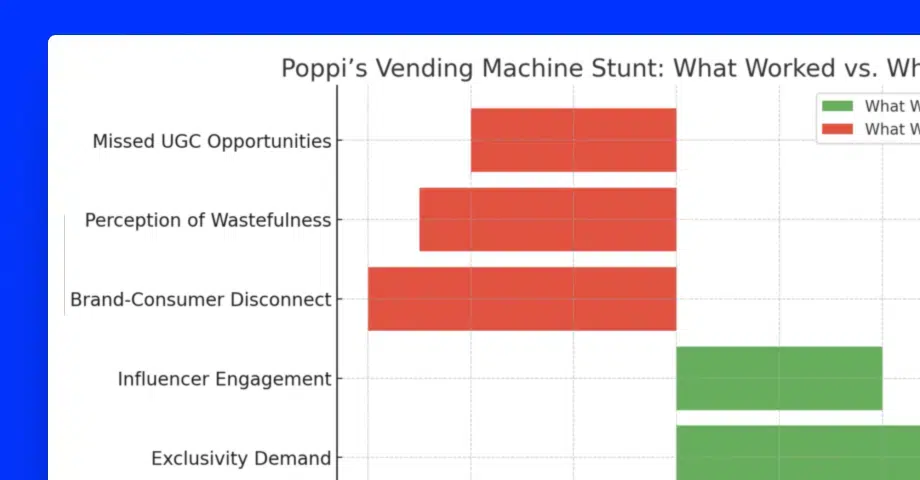
Key insights from the analysis:
- Sentiment split—While many praised the stunt’s creativity and alignment with pop culture events like the Super Bowl, others criticized it as tone-deaf or exclusionary.
- Topic clustering—Discussions tied the campaign to broader cultural conversations, including Taylor Swift, the Eagles, and UGC virality.
- What worked—The physical spectacle drove buzz, influencer alignment paid off, and the brand hit peak visibility.
- What didn’t—Poppi risked alienating everyday customers by favoring macro-influencers and missed deeper UGC opportunities by not including grassroots fans.
The takeaway:
A social listening tool like EmbedSocial surfaces both the applause and the backlash—providing a roadmap for more inclusive, community-driven campaigns in the future.
3. Paris Fashion Week
To explore how users responded to one of the fashion world’s biggest events, we analyzed over 6,500 posts around #ParisFashionWeek and #PFW. Our goal? Understand how the conversation unfolded and what brands could learn from audience behavior:
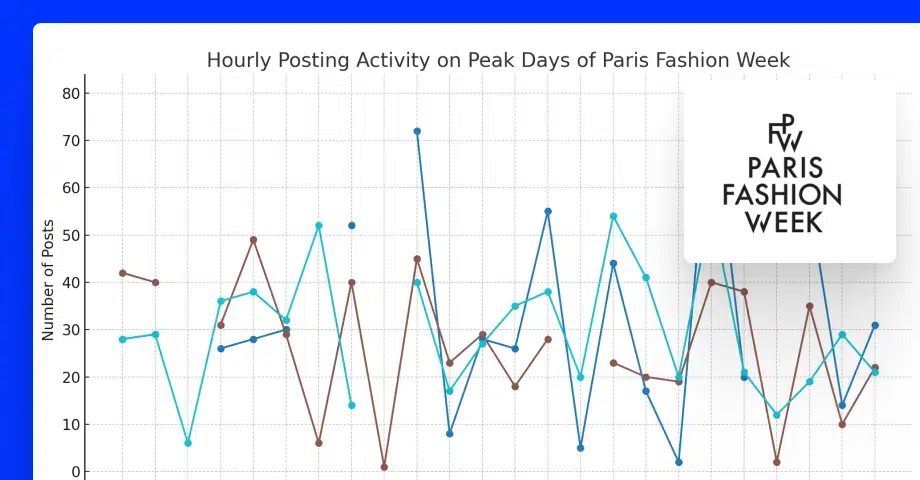
Top findings from the listening report:
- Text-driven conversations—Over 4,000 of the posts were text-based, suggesting untapped potential in video and carousel content.
- Event-specific peaks—Engagement spiked on days of major runway shows, highlighting opportunities for real-time content publishing.
- Brand sentiment breakdown—Chanel, Valentino, Dior, and Louis Vuitton all enjoyed mostly positive mentions, though some brands lagged in engagement volume.
- Emerging keywords—Audiences talked about luxury, emerging trends, and exclusivity—giving marketers a content goldmine for next season’s campaigns.
The takeaway:
Paris Fashion Week isn’t just a runway event—it’s a digital storytelling moment. Social listening helped reveal which brands rose to the occasion and which still have room to optimize their UGC strategies.
How do big brands utilize social listening for marketing purposes?
Even the biggest brands out there rely on social listening to profit from the latest viral trends, including the following:
McDonald’s: Engaging with viral trends
McDonald’s excels at using social media listening to monitor and engage with viral trends. A notable example is their response to the 2023 Grimace Shake trend on TikTok.
- Situation: After launching the Grimace Shake as part of a promotional campaign, McDonald’s noticed a surge in user-generated content on TikTok, where customers created humorous and sometimes eerie videos featuring the shake.
- Action: By actively listening to social media conversations, McDonald’s identified this trend and chose to engage playfully. They posted a meme stating: “me pretending I don’t see the grimace shake trend”, showcasing their awareness and sense of humor.
- Outcome: This engagement amplified the trend, leading to increased brand visibility and positive customer interactions across multiple platforms.
Nike: Understanding customer preferences
Nike employs social listening to gain insights into customer preferences and emerging trends, allowing them to tailor their marketing strategies effectively.
- Situation: By monitoring social media discussions, Nike identified a growing interest in sustainable and eco-friendly products among their target audience.
- Action: Leveraging this insight, Nike expanded their line of sustainable footwear and apparel, promoting these products through targeted social media campaigns that resonated with environmentally conscious consumers.
- Outcome: This approach strengthened Nike’s brand image as a leader in sustainability and increased engagement with a key customer segment.
Starbucks: Navigating Reputational Crises
Starbucks often utilizes social media listening to manage its online brand reputation and respond promptly to potential crises.
- Situation: In 2018, in a Philadelphia store two Black men were arrested while waiting for a friend, which led to led to widespread social media backlash about racial profiling.
- Action: Through vigilant social listening, Starbucks quickly became aware of the situation and the ensuing negative sentiment. The company responded by issuing a public apology, closing stores nationwide for racial bias training, and engaging directly with affected individuals.
- Outcome: Starbucks’ prompt and comprehensive response helped mitigate the crisis, demonstrating the company’s commitment to addressing social issues and maintaining customer trust.
These examples illustrate how brands can leverage social media listening to engage with trends, understand customer preferences, and manage their online reputation.
Conclusion: Start social listening today to elevate your brand!
Regardless of your industry, successful business ideas are born after you fully understand your customers, their needs, and their problems.
Well, social listening is the best way to do that as you are getting raw and unprompted opinions straight from your customers.
Additionally, you get plenty of other benefits, such as staying ahead of your competitors, preventing PR crises, and delivering improved products and services.
To save tons of valuable time, money, and effort by listening to your customers, you need the right tools for the job, such as EmbedSocial—provides insights about your products and competitors and builds captivating social media feeds!
What are you waiting for? Start creating your social listening strategy today!
FAQ about social listening
What do you mean by social listening?
Social listening refers to the process of monitoring online conversations about your brand, competitors, or industry to understand public sentiment, identify trends, and gain actionable insights for improving strategies.
What are social listening tools?
Social listening tools are software solutions that track, analyze, and report on online conversations about your brand, competitors, or industry, helping you uncover insights, monitor sentiment, and inform strategic decisions.
What is an example of social media listening?
An example of social media listening is Starbucks monitoring Twitter for mentions of its new holiday drink. By analyzing the sentiment of these mentions, the brand can gauge customer reactions, address complaints, and refine its marketing strategy.
How can social media listening increase customer advocacy?
By identifying happy customers who are organically talking about your brand, you can turn them into advocates. Respond to their posts, feature them in your UGC campaigns, and engage them in loyalty or affiliate programs. Listening helps you catch these moments in real time and amplify them with minimal effort.
How do I know which social networks to start with for social listening?
Start where your customers are most active. For most brands, that means Instagram, X (formerly Twitter), and YouTube. Look at where you’re getting the most mentions, comments, or hashtags. Focus your listening on those channels first, then expand based on new trends or campaigns.
What are the three types of social listening?
The three types of social listening are:
Combined social listening—blending brand-specific and industry-wide listening for a comprehensive view of conversations and opportunities.
Basic social listening—focusing on tracking brand mentions and direct customer feedback to monitor online presence;
Deep social listening—analyzing broader industry trends, competitor activities, and audience sentiment to uncover strategic insights;
How can social listening help a marketer?
Social listening helps marketers understand what audiences are saying about their brand, competitors, and industry in real time. It reveals emerging trends, customer sentiments, and content opportunities to improve campaigns and product strategies.
How is social listening measured?
Social listening is measured using key metrics such as:
Brand awareness—how recognizable your brand is measured through reach.
Sentiment score—the ratio of positive, negative, and neutral mentions about your brand;
Share of voice—how often your brand is mentioned compared to competitors;
Engagement rate—interactions like likes, comments, and shares on tracked content;
Reach—the potential audience size exposed to mentions of your brand;
Conversion rate—the number of leads or sales generated from social listening insights;
What’s the difference between social listening and social monitoring?
Here is the main difference between social listening and social monitoring:
Social monitoring tracks direct mentions, tags, or comments about your brand (what’s being said).
Social listening looks at broader conversations, trends, and sentiment—even when your brand isn’t tagged (why it’s being said).
Use monitoring for real-time engagement, and listening to guide strategy.
How can social media monitoring inform your sales and product teams?
Monitoring reveals what customers are saying about your products, competitors, and pain points. Sales teams can use this for lead intel or objection handling. Product teams can discover feature requests, bugs, or trending use cases—direct from real users.
What metrics matter in social listening?
Key metrics include sentiment analysis, mention volume, engagement on mentions, top keywords, and share of voice. Track how these change over time to see how brand perception evolves.
Why should you add common misspellings of your brand name to your social listening keywords?
Including common misspellings of your brand name ensures you catch all relevant mentions, even when users make typos. This helps you avoid missing valuable feedback, questions, or potential crises.
